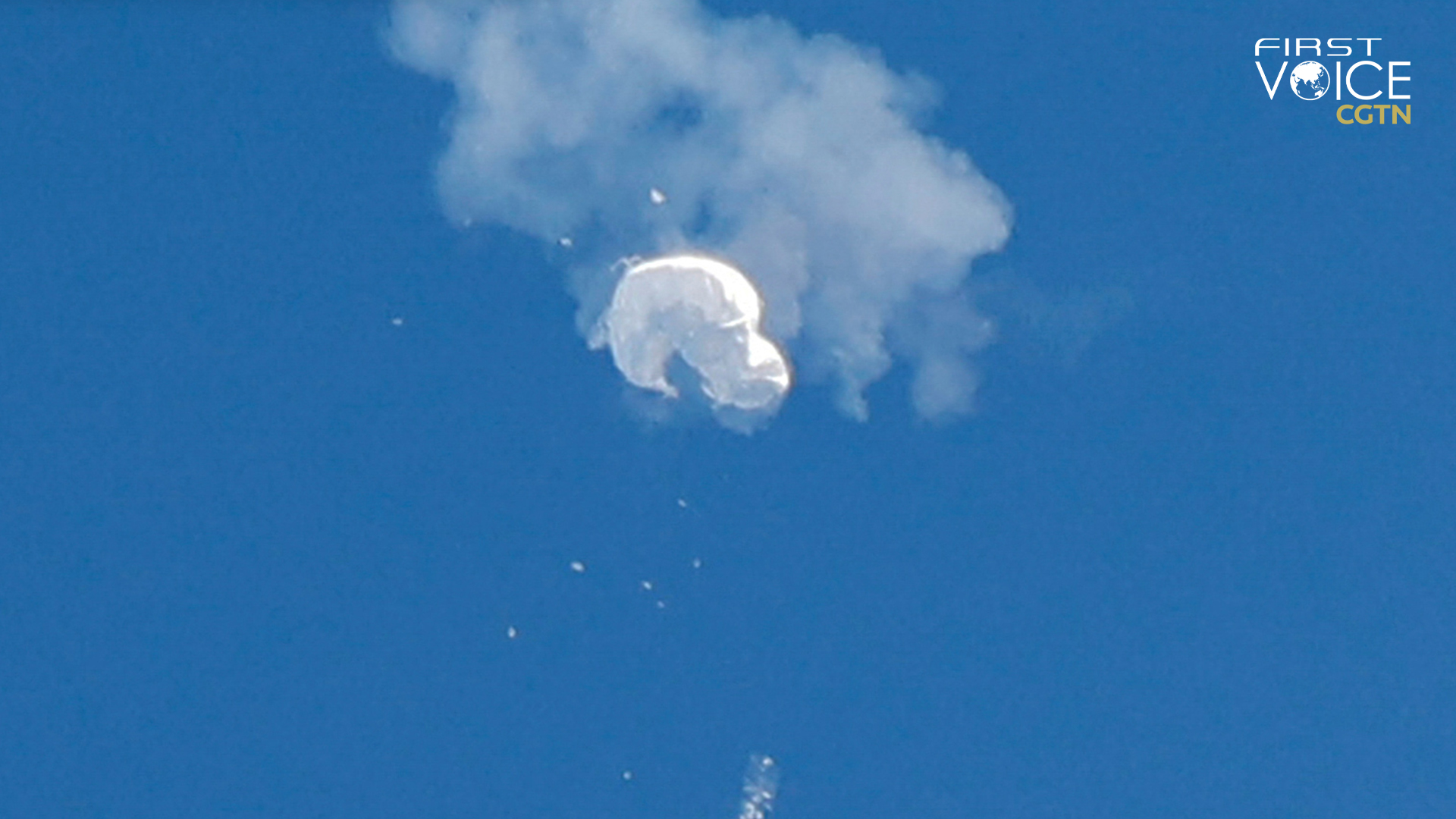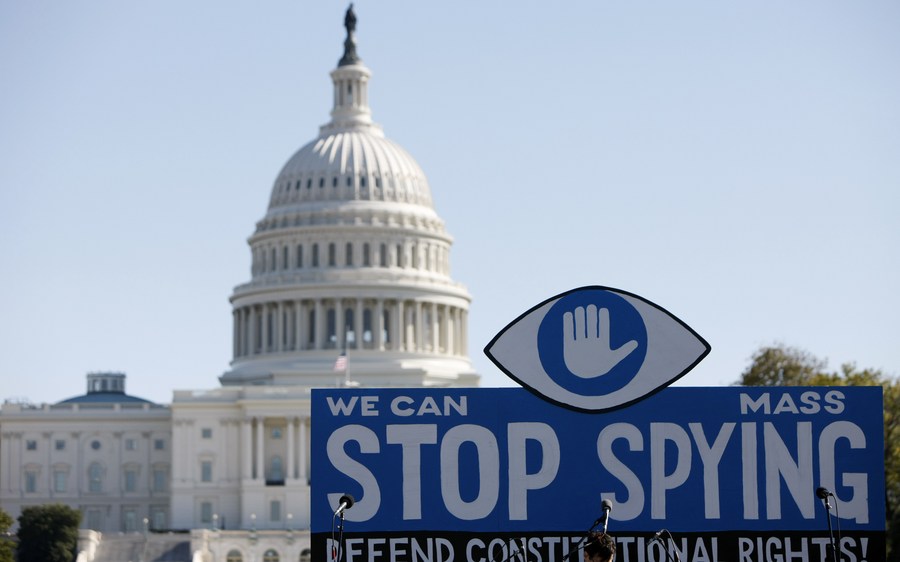
Editor's note: CGTN's First Voice provides instant commentary on breaking stories. The column clarifies emerging issues and better defines the news agenda, offering a Chinese perspective on the latest global events.
On April 3, NBC News reported that two current senior U.S. officials and a former senior administration official said that the Chinese high-attitude weather test balloon shot down by the United States was "able to gather intelligence from several sensitive American military sites." And the information gathered, according to these sources, could be transmitted to Beijing in real time.
According to Reuters, the White House and the Pentagon said that they could not confirm such an account.
It has been two months since the incident happened. Here are the salient points:
A high-altitude Chinese weather balloon, affected by weather and with limited self-steering capability, deviated from its planned course and drifted into the U.S. Accepting its ownership, China clarified that it was an "unmanned civilian airship" used for research, mainly meteorological purposes. Regretting the unintended entry of the airship into the U.S. airspace, China had expressed its desire to continue communicating with the U.S. side and properly handle this unexpected situation.
How did the U.S. respond?
Egged on by its frenzied media and going against the expected international norms, the U.S. made a spectacle of the incident before its Air Force F-22 Raptor, on orders from President Joe Biden, shot the alleged "spy balloon" down in a grand show.

A screenshot of NBC News' story on two current senior U.S. officials and a former senior administration official's account of China's "spy balloon."
A screenshot of NBC News' story on two current senior U.S. officials and a former senior administration official's account of China's "spy balloon."
The U.S. didn't stop there. In signs of further agitation, aggression and even panic, the U.S. went after at least three more airborne objects and shot them down. None of these flying objects were confirmed as either belonging to China or even being the so-called "spy balloons." On the contrary, reports suggest that these might have been operated by private research organizations with one most likely belonging to an amateur club in Illinois.
It is therefore clear that the U.S. government's decision of shooting down the balloons was unwarranted and aggressive and driven by the zeal to humiliate China, more so when the U.S. Department of Defense had already stated that "the balloon does not present a military or physical threat to people on the ground." In any case, the Chinese airship shot down by the U.S. was too big in size and visible to be used as a "spy balloon."
This sets a dangerous precedent. It sends a message to other countries that the U.S. is willing to use military force to protect its own interests, even when those interests are not threatened.
It also highlighted the double standards of the U.S. government. It is quite well-known that over the years, the U.S. has used spy balloons to conduct surveillance on other countries, including China, which undermines Washington's credibility in accusing Beijing of spying. According to China's Foreign Ministry Spokesperson Wang Wenbin, since last year, U.S. high-altitude balloons had flown over Chinese airspace over ten times without authorization from China, yet the U.S. side never gave an open and transparent response to this.

A huge slogan board stands in front of the U.S. Capitol building during a protest against government surveillance in Washington, D.C., U.S., October 26, 2013. /Xinhua
A huge slogan board stands in front of the U.S. Capitol building during a protest against government surveillance in Washington, D.C., U.S., October 26, 2013. /Xinhua
The U.S. has a long history of using surveillance balloons to gather intelligence on other countries. For example, during the Cold War, the U.S. launched balloons to spy on the Soviet Union, and more recently, the U.S. has used balloons to monitor activities in the Middle East. In both cases, the U.S. government justified its actions by citing national security concerns.
Furthermore, the U.S. has also been implicated in more egregious forms of espionage, such as the global surveillance programs revealed by whistle-blower Edward Snowden. These programs involved the collection of vast amounts of data from individuals and governments around the world, without any clear justification or oversight.
Given this history, it is hypocritical for the U.S. to create a narrative that China is allegedly conducting espionage through research balloons. The U.S. government's accusations against China are frivolous and seem to be driven more by political considerations than actual evidence.
Now, two months after the incident, as China engages in intensive diplomatic actions with leaders around the world coming to visit, the U.S. government is again on the offensive, resuscitating a nearly dead story to distract the world from the productive engagements happening between various heads of states. Just days ahead of the French President Emmanuel Macron's scheduled visit to China on April 5, a baseless accusatory story quoting "anonymous sources" would certainly be a good way to get media's attention and a shot across the bows to any Western leader that might have intentions to work more closely with China.
It should be a warning to all countries in the world that, with its double-standard and hypocritical accusations, the United States have no qualms of using anything in its arsenal – military and economic to rhetorical or anything else – to try to take down its "adversaries" or "competitors." As the country leans more towards re-fighting the Cold War, its tactics are getting more Cold-War-like: self-serving, sneaky and insidious.
(If you want to contribute and have specific expertise, please contact us at opinions@cgtn.com. Follow @thouse_opinions on Twitter to discover the latest commentaries in the CGTN Opinion Section.)